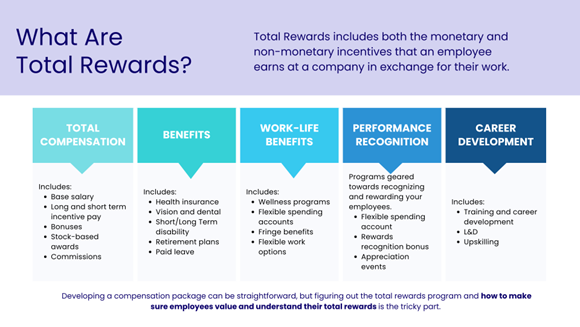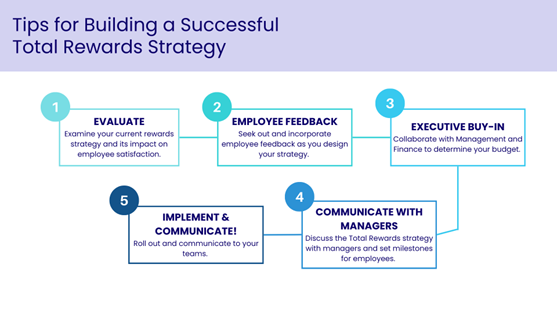Attracting and retaining top talent is more challenging than ever.
Enter the concept of Total Rewards—a holistic approach to employee compensation that goes beyond just salary to include a variety of benefits, incentives, and career development opportunities.
In this blog post, we’ll explore what Total Rewards are, why they are crucial for employees, what they typically include, and how small to medium sized businesses (SMBs) can leverage them to create an exceptional workplace.
What Are Total Rewards?
Total Rewards is a strategic approach to employee compensation. It goes beyond the traditional concept of pay and benefits.
It recognizes that employees value more than just their paycheck. It includes all aspects of work that employees find rewarding.
Total Rewards refers to the complete package of compensation, benefits, and other perks provided to employees in exchange for their work. This comprehensive approach considers not only financial compensation but also non-monetary benefits that enhance the overall employee experience.
Regardless of size, companies are struggling with offering competitive total compensation. According to a study by Aflac, almost half of all employers say that they are struggling.
The goal of any Total Rewards program is to attract, motivate, and retain employees. It’s a comprehensive strategy for creating an exceptional workplace.
5 Key Components of Total Rewards
1. Compensation
This includes base salary, bonuses, commissions, and any other form of direct financial payment. It is about more than just competitive pay. It’s about ensuring that employees feel fairly compensated for their work.
2. Benefits
Include all the things to keep your team healthy, such as health and dental insurance, paid leave.
3. Work-Life Benefits
Work-life imbalances are one of the biggest reasons for employee turnover and employers who recognize this ensure solutions are included in their total rewards programs. This could include things like flexible work hours, remote work options, hybrid options, flexible spending accounts, or other benefits.
It’s about helping employees balance their work responsibilities with their personal lives. This can lead to increased job satisfaction and reduced stress.
4. Performance Recognition
This includes performance-based rewards and employee recognition programs.
This pillar is about acknowledging and rewarding employees for their hard work. It’s a key driver of employee motivation and engagement.
5. Career Development
Development and Career Opportunities is the final pillar of Total Rewards. This includes training programs, career development opportunities, and succession planning.
This pillar is about supporting employees in their career growth. It’s about helping them develop new skills and advance within the organization.
Most people, when entering a role, will ask: What is the opportunity for growth? Are people being promoted, is there a Learning and Development or Upskilling budget?

The Importance of Total Rewards in the Workplace
Total Rewards are more than just a compensation strategy. It’s a powerful tool for creating an exceptional workplace.
By addressing the diverse needs and values of employees, Total Rewards can help attract top talent. It can also help retain high-performing employees, reducing turnover costs.
Moreover, Total Rewards can boost employee engagement and satisfaction. When employees feel valued and supported, they’re more likely to be productive and committed to their work.
In short, Total Rewards are a key driver of organizational success. It’s a strategic approach to managing and rewarding your most valuable asset: your employees.
Attracting and Retaining Talent
In today’s competitive job market, attracting and retaining top talent is a major challenge. Total Rewards can be a game-changer.
A robust Total Rewards program can make your organization stand out. It can help attract high-quality candidates who are looking for more than just a paycheck.
Moreover, Total Rewards can help retain your best employees. By meeting their diverse needs and values, you can increase their job satisfaction and loyalty.
Boosting Employee Engagement and Satisfaction
Employee engagement and satisfaction are crucial for organizational success. Total Rewards can play a key role in boosting these factors.
When employees feel recognized and rewarded, they’re more likely to be engaged in their work. They’re more likely to put in additional effort and go the extra mile.
Moreover, a comprehensive Total Rewards program can increase job satisfaction. When employees feel that their needs and values are being met, they’re more likely to be satisfied with their job. And satisfied employees are more likely to stay with the organization.
Why Are Total Rewards Important?
A Total Rewards strategy shows how much your organization values its employees. Here’s why they matter:
- Attracting Top Talent
- Retaining current employees
- Creating a more loyal and engaged workforce
- Strengthening employee performance
- Creating a culture of care and investment in employees’ personal growth
Implementing Total Reward Strategies
Implementing Total Rewards strategies requires careful planning and execution. It’s not just about offering a mix of rewards. It’s about aligning these rewards with your organizational goals and employee values.
Here are 5 steps on how to build a successful Total Rewards Strategy.

Evaluate
Consider your current offerings. Analyze your existing plans and tactics and their correlation with employee happiness. Reflect on what your immediate and future business objectives are.
Employee Feedback
Communicate with your team. What are their priorities? Could you be overlooking something that greatly motivates and drives them? Involve them in this process as they are the beneficiaries of these actions.
Executive Buy-In
Once you have a grasp of the current state and what your team needs, connect with your management team and Finance to determine the budget you have.
Communicate with Managers
Communicate with team leaders. Let them know what programs you can implement and work with them to set milestones for their teams.
Implement and Communicate
As you roll out your Total Rewards strategy it’s really important to communicate this early and often. Just sending one email, or a Slack message likely won’t resonate. Make sure you’re communicating what the new changes are, what programs you’re offering and how your team can access these.
Tips for Creating an Exceptional Workplace with Total Rewards
Creating an exceptional workplace is about more than just offering competitive salaries. It’s about creating an environment where employees feel valued, engaged, and motivated. Total Rewards can play a key role in this.
Here are some tips for using Total Rewards to create an exceptional workplace:
- Embrace flexibility and work-life balance
- Foster a culture of recognition and growth
- Personalize rewards to fit diverse employee needs
- Communicate the value of Total Rewards effectively
Embracing Flexibility and Work-Life Balance
In today’s fast-paced world, work-life balance is more important than ever. Employees value the flexibility to balance their work and personal lives. Total Rewards can support this by offering flexible working arrangements, remote work options, and generous leave policies.
Solutions such as LIVD – a mobile app for employee fringe benefits – make this process easy for companies and their teams. As an employer, you can easily set a budget per employee, and your team can then decide how they want to use those dollars on the LIVD platform, selecting from several hundred well-known brands. Make it easy to personalize how you reward your team.
Remember, work-life balance is not just about offering flexible hours. It’s about creating a culture that respects and supports employees’ personal lives. This can lead to increased job satisfaction, improved mental health, and higher productivity.
Fostering a Culture of Recognition and Growth
Recognition is a powerful motivator. When employees feel recognized and appreciated, they are more likely to be engaged and productive. Total Rewards can foster a culture of recognition through performance incentives, employee recognition programs, and career development opportunities.
Growth is another key aspect of an exceptional workplace. Employees want to feel that they are learning, growing, and advancing in their careers. Total Rewards can support this by offering training programs, mentorship opportunities, and clear career progression paths.
The Future of Total Rewards
As we move into the future, Total Rewards will continue to evolve. The focus will shift even more towards personalization, flexibility, and work-life balance. Technology will play a key role in this, enabling companies to tailor their rewards programs to the individual needs and preferences of their employees, which is what we’ve built with LIVD.
Total Rewards is not just a strategy for attracting and retaining talent. It’s a powerful tool for creating an exceptional workplace, boosting employee engagement, and driving business success. By understanding and implementing Total Rewards effectively, companies can set themselves up for a successful future.

